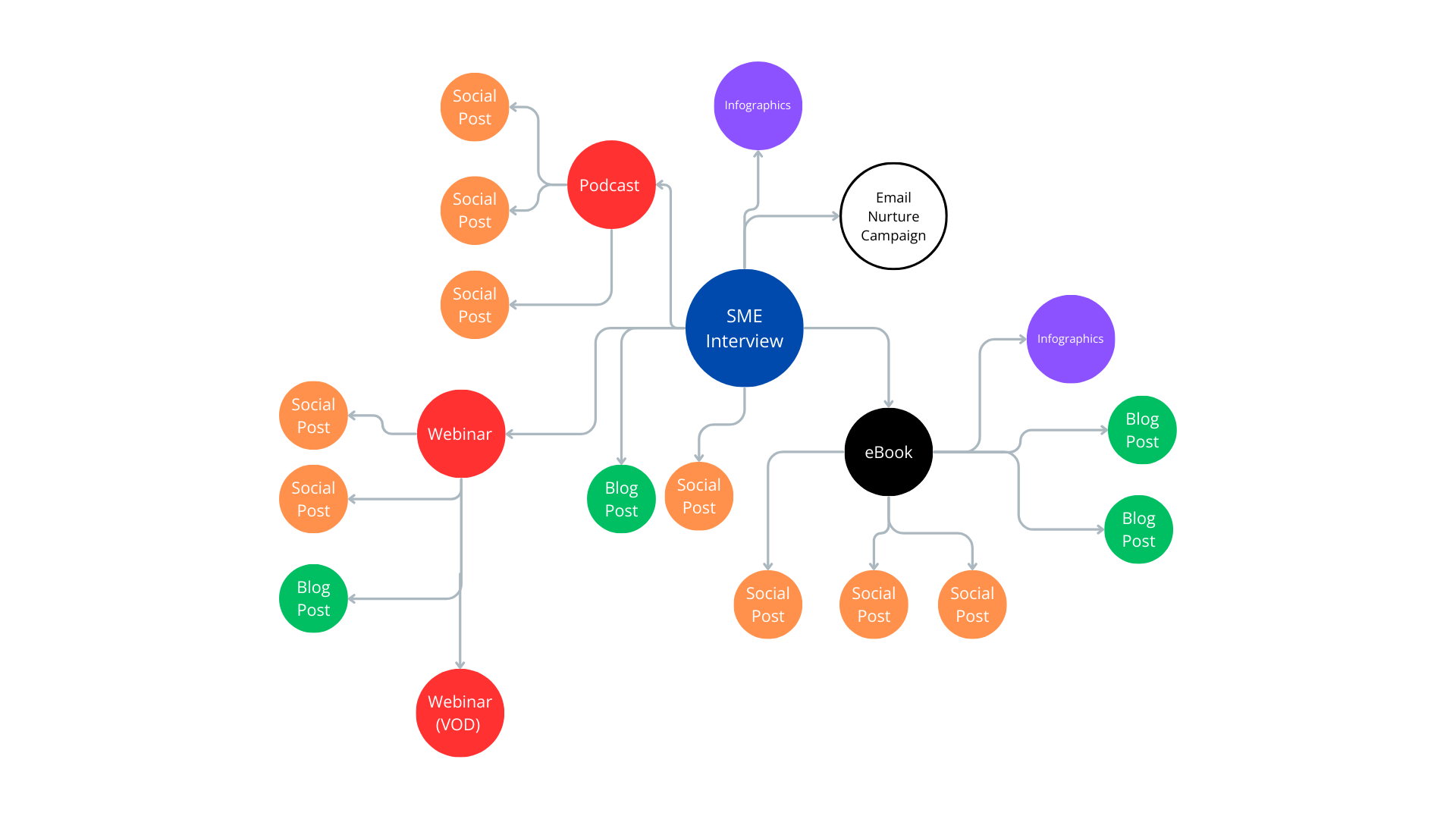Best Practices for Subject Matter Expert Interviews (+ Sample Questions)

Subject Matter Expert (SME) interviews are goldmines for marketers. Instead of using them as one-off content pieces, a single interview can be repurposed for blogs, ebooks, videos, social media, and more.
In this piece, we’ll share our best practices we’ve learned from conducting hundreds of SME interviews for clients, with our SME Interview Assistant to get you started with questions.
How to Use Our SME Interview Assistant
Just answer a few questions about your Subject Matter Expert or your product — or a link to their LinkedIn page — and our SME Interview Assistant will generate sample questions for you.
Remember: the more information you give it, the better your questions will get. You can keep refining it until you’re happy with the results — then have the final SME questions emailed to you.
Interview Once; Use Everywhere
The entire point of conducting an SME interview is to take that expertise and bring it to an audience. Squeeze as much value from that interview as possible.
The key idea is repurposing. By taking SME content intended for one objective (informing a whitepaper, providing a customer story, etc.) and using it across all your marketing, this gives you:
- Efficiency: Creating high-quality content takes time and effort. You can make even more by repurposing that content into complementary assets (social media, video, etc.). This is a great benefit for busy marketing managers with budgets (and according to ReferralRock, 65% of marketers agree with that sentiment).
- Reach: Different people prefer different types of content. Repurposing allows you to reach a broader audience who may not have engaged with the original format.
- Reinforcement: A big part of marketing is ensuring that customers see your messaging repeated in different contexts. By repurposing this content, you can create a network of reinforcement where ideas are consistently communicated in different ways without contradicting each other.
- Authority: Consistently providing valuable information across various platforms can establish you as an authority in your field.
Marketer’s Takeaway: Based on our experience running hundreds of SME interviews, we recommend that you come into SME interview understanding it as part of a larger project or campaign. Reuse and repurpose, so you can squeeze every last drop out of that interview.
Building a Content Plan Around a SME Interview

Sometimes, a SME interview supports the content. In other contexts, a SME interview can become the content.
Savvy marketers can leverage SME engagement to spin off entire content campaigns. Planning these campaigns should revolve around how different pieces of content support one another as part of a larger strategy or funnel. A few things to keep in mind:
- Create a Blueprint: Think about what you’re trying to accomplish. In some cases, you may have a campaign idea before considering your SME, while in other cases, your SME interview might inspire a campaign. Generally speaking, it helps to have a broad understanding of your objectives before planning a SME interview. This will help you effectively develop content from that interview (and adjust your questions during the interview).
- Think About Repurposing: Even if you’ve planned a big pillar asset for your campaign, you should also think about the content you will spin out from it — whether social media or translating the original content into new formats.
- Maintain a List of Insights and Quotes: You should be recording the interview (bonus points if the SME gives you permission to share audio or video). Use this as a way to pull killer quotes across your different assets. Using the same quote across a content funnel can create a sense of cohesion and repetition to the message.
Marketer’s Takeaway: Consider the big pillars of content that will come from the interview (webinars, eBooks, whitepapers, customer stories) and the scaffold content campaigns onto that (social media posts, bite-sized video content, blog posts, etc.). Adjust and adapt, depending on what your SME interviewee gives you.
Types of New Content from SME Interviews
There are many types of content that you can create from a well-executed SME interview:
Worthwhile content to pull from SME interviews includes:
- Case Studies and Customer Stories: If the SME provides information about a specific operation, project, or customer interaction, consider building a narrative around that knowledge. Stories move people. With specific examples or scenarios, you can turn these into detailed case studies or customer success stories.
- Ebooks and White Papers: Combine the interview with additional research to create comprehensive guides or reports that can drive conversions and promote thought leadership. Depending on your lead gen strategy, ebooks and white papers are core assets to drive conversions on landing pages (we have a series on just this subject).
- Podcasts: If you’ve been granted permission to record the interview, you can release it as a podcast or video interview on your site or socials.
- Full-Length Videos: According to Gitnux, 85% of US Internet users watch online videos monthly on their devices. You can publish the interview in full, or edited segments, posted to YouTube or your website. Webinars are another form of video that can be broken into bite-sized videos for sharing across various channels.
Marketer’s Takeaway: A few core types of content can make an SME interview sing. Long-form videos, downloadables, case studies, customer stories, and podcasts are a great foundation for a good interview. Again, if the SME agrees to do public interviews, then all the better. These will all lead to effective repurposing down the road.
Building Content Campaigns Around SME Interviews

With content in hand, it’s time to think about spinning off new pieces of content to support, amplify, or create longevity for your existing assets. “Repurposing” is the process of breaking down existing content or reshaping it (in part or in whole) to release it into the market in a new form.
More accurately, repurposing can be considered “expanding” or “distributing” information from that SME interview across different media channels.
Because these media channels are focused on different media for different audiences, repurposing content means paying extra attention to how the heart or spirit of that content speaks to that particular audience.
Some ideas for repurposing your existing SME content include:
- Long-Form Content → Blog Series: It’s good practice to take a longer-form eBook or case study from a SME interview and spin it into blogs. These blogs can represent pieces of the original (like a blog summarizing a chapter) or cover more expanded ideas that drive back to the original.
- Long-Form Content → Email Nurture Campaigns: Because of the piecemeal nature of some longer-form content types, it’s natural to break it out into an email campaign. Unlike blogs, which can thrive as standalone assets, email nurture campaigns can work very well with step-by-step instructions or processes.
- SME Interviews + Long-Form Content → Infographics: Once you’ve got longer assets in hand, you can use supporting infographics to highlight the data narratives in (or between) those assets. According to Semrush, 17% of marketers believe that infographics are their best-performing content format.
- Podcasts + Videos + SME Interviews → Webinars and Slide Decks: Webinars are incredibly popular right now due to the ease of producing and presenting streaming video. A webinar featuring a downloadable slide deck can provide a more interactive complement to existing video and audio assets.
- Long-Form Media → Short-Form Audio and Video (Microcontent): Social media marketing has increasingly turned to animation and video to attract attention. By slicing and dicing existing video and audio interviews, you can provide quick, bite-sized pieces of content across all your socials.
- Written Content → Video Content: If you’re creating blogs from a longer piece of content, it’s probably a good idea to consider translating the blog into a long video. This video can take the entire blog text (or however much needed) and present it in video form.
Marketer’s Takeaway: The purpose (pun intended) of repurposing content is to give the original assets and information increased longevity while reaching new audiences across different channels. Atomizing your existing content into bite-sized content pieces works great, as does translating old content into new (for example, written content into audio or video assets).
How to Repurpose Content

Repurposing a SME interview across multiple channels and multiple layers of a campaign isn’t a plug-and-play proposition. You need to understand how your campaign worked, how you presented your SME and their insights, and in what ways you’ll need to update or refresh that content.
- Stick with Evergreen Content: The insights provided could be more or less time-dependent, depending on the SME. Create content that can stand up over time with little or no maintenance. If using data that will update over time, just realize that you’ll need to update it regularly to repurpose it.
- Identify High-Performing Content: When you start repurposing, select content that has already performed well regarding engagement, reach, or conversions. This may perform equally well, or better, with a second wind.
- Determine New Formats: Decide which formats would suit your target audience. If they enjoy video, for example, consider a development funnel that eventually leads all content into video form, whether through initial production or as repurposed content.
- Adapt and Update: Make necessary changes to adapt the content to the new format. Update any outdated information regularly as you do so, and don’t be afraid to add some new information to provide a modern context for older data.
- Optimize for Platform: Each platform has its own best practices for content. Make sure to optimize your repurposed content accordingly.
- Promote: Distribute the repurposed content through appropriate channels and monitor its performance.
- Analyze and Adjust: Use analytics to measure the success of your repurposed content and make any necessary adjustments.
Marketer’s Takeaway: At this point, you’ve given that SME interview not just a second life, but a third life, transforming it into additional campaigns that can still reach new audiences. With strategic repurposing, you can spin off a single SME interview into months of great market exposure.
Marketer’s Takeaway
One great SME interview can go a long way. You can not only pull multiple stories out of a single interview, but use that interview for multiple content assets.
With Media Shower, you get a collection of professional designers, writers, and strategists who can help you plan your new SME content and repurpose it into full campaigns. And, with our Media Shower platform, you get all of that through an easy-to-use process. Click here to give us a try.



